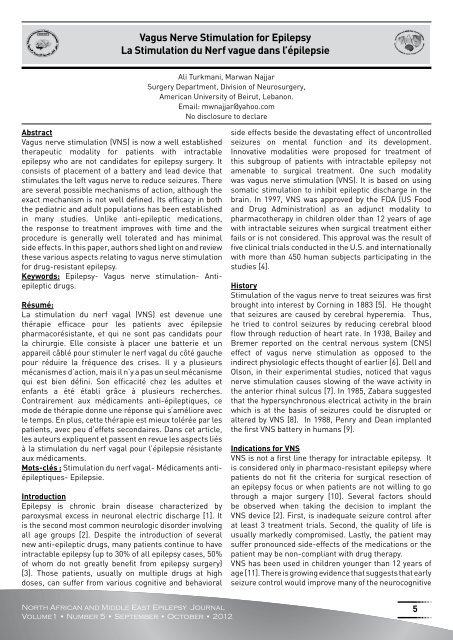In partnership with : - CHU - Marrakech
In partnership with : - CHU - Marrakech
In partnership with : - CHU - Marrakech
Create successful ePaper yourself
Turn your PDF publications into a flip-book with our unique Google optimized e-Paper software.
Vagus Nerve Stimulation for Epilepsy<br />
La Stimulation du Nerf vague dans l’épilepsie<br />
Abstract<br />
Vagus nerve stimulation (VNS) is now a well established<br />
therapeutic modality for patients <strong>with</strong> intractable<br />
epilepsy who are not candidates for epilepsy surgery. It<br />
consists of placement of a battery and lead device that<br />
stimulates the left vagus nerve to reduce seizures. There<br />
are several possible mechanisms of action, although the<br />
exact mechanism is not well defined. Its efficacy in both<br />
the pediatric and adult populations has been established<br />
in many studies. Unlike anti-epileptic medications,<br />
the response to treatment improves <strong>with</strong> time and the<br />
procedure is generally well tolerated and has minimal<br />
side effects. <strong>In</strong> this paper, authors shed light on and review<br />
these various aspects relating to vagus nerve stimulation<br />
for drug-resistant epilepsy.<br />
Keywords: Epilepsy- Vagus nerve stimulation- Antiepileptic<br />
drugs.<br />
Résumé:<br />
La stimulation du nerf vagal (VNS) est devenue une<br />
thérapie efficace pour les patients avec épilepsie<br />
pharmacorésistante, et qui ne sont pas candidats pour<br />
la chirurgie. Elle consiste à placer une batterie et un<br />
appareil câblé pour stimuler le nerf vagal du côté gauche<br />
pour réduire la fréquence des crises. Il y a plusieurs<br />
mécanismes d’action, mais il n’y a pas un seul mécanisme<br />
qui est bien défini. Son efficacité chez les adultes et<br />
enfants a été établi grâce à plusieurs recherches.<br />
Contrairement aux médicaments anti-épileptiques, ce<br />
mode de thérapie donne une réponse qui s’améliore avec<br />
le temps. En plus, cette thérapie est mieux tolérée par les<br />
patients, avec peu d’effets secondaires. Dans cet article,<br />
les auteurs expliquent et passent en revue les aspects liés<br />
à la stimulation du nerf vagal pour l’épilepsie résistante<br />
aux médicaments.<br />
Mots-clés : Stimulation du nerf vagal- Médicaments antiépileptiques-<br />
Epilepsie.<br />
<strong>In</strong>troduction<br />
Epilepsy is chronic brain disease characterized by<br />
paroxysmal excess in neuronal electric discharge [1]. It<br />
is the second most common neurologic disorder involving<br />
all age groups [2]. Despite the introduction of several<br />
new anti-epileptic drugs, many patients continue to have<br />
intractable epilepsy (up to 30% of all epilepsy cases, 50%<br />
of whom do not greatly benefit from epilepsy surgery)<br />
[3]. Those patients, usually on multiple drugs at high<br />
doses, can suffer from various cognitive and behavioral<br />
Ali Turkmani, Marwan Najjar<br />
Surgery Department, Division of Neurosurgery,<br />
American University of Beirut, Lebanon.<br />
Email: mwnajjar@yahoo.com<br />
No disclosure to declare<br />
North African and Middle East Epilepsy Journal<br />
Volume1 • Number 5 • September • October • 2012<br />
side effects beside the devastating effect of uncontrolled<br />
seizures on mental function and its development.<br />
<strong>In</strong>novative modalities were proposed for treatment of<br />
this subgroup of patients <strong>with</strong> intractable epilepsy not<br />
amenable to surgical treatment. One such modality<br />
was vagus nerve stimulation (VNS). It is based on using<br />
somatic stimulation to inhibit epileptic discharge in the<br />
brain. <strong>In</strong> 1997, VNS was approved by the FDA (US Food<br />
and Drug Administration) as an adjunct modality to<br />
pharmacotherapy in children older than 12 years of age<br />
<strong>with</strong> intractable seizures when surgical treatment either<br />
fails or is not considered. This approval was the result of<br />
five clinical trials conducted in the U.S. and internationally<br />
<strong>with</strong> more than 450 human subjects participating in the<br />
studies [4].<br />
History<br />
Stimulation of the vagus nerve to treat seizures was first<br />
brought into interest by Corning in 1883 [5]. He thought<br />
that seizures are caused by cerebral hyperemia. Thus,<br />
he tried to control seizures by reducing cerebral blood<br />
flow through reduction of heart rate. <strong>In</strong> 1938, Bailey and<br />
Bremer reported on the central nervous system (CNS)<br />
effect of vagus nerve stimulation as opposed to the<br />
indirect physiologic effects thought of earlier [6]. Dell and<br />
Olson, in their experimental studies, noticed that vagus<br />
nerve stimulation causes slowing of the wave activity in<br />
the anterior rhinal sulcus [7]. <strong>In</strong> 1985, Zabara suggested<br />
that the hypersynchronous electrical activity in the brain<br />
which is at the basis of seizures could be disrupted or<br />
altered by VNS [8]. <strong>In</strong> 1988, Penry and Dean implanted<br />
the first VNS battery in humans [9].<br />
<strong>In</strong>dications for VNS<br />
VNS is not a first line therapy for intractable epilepsy. It<br />
is considered only in pharmaco-resistant epilepsy where<br />
patients do not fit the criteria for surgical resection of<br />
an epilepsy focus or when patients are not willing to go<br />
through a major surgery [10]. Several factors should<br />
be observed when taking the decision to implant the<br />
VNS device [2]. First, is inadequate seizure control after<br />
at least 3 treatment trials. Second, the quality of life is<br />
usually markedly compromised. Lastly, the patient may<br />
suffer pronounced side-effects of the medications or the<br />
patient may be non-compliant <strong>with</strong> drug therapy.<br />
VNS has been used in children younger than 12 years of<br />
age [11]. There is growing evidence that suggests that early<br />
seizure control would improve many of the neurocognitive<br />
5


